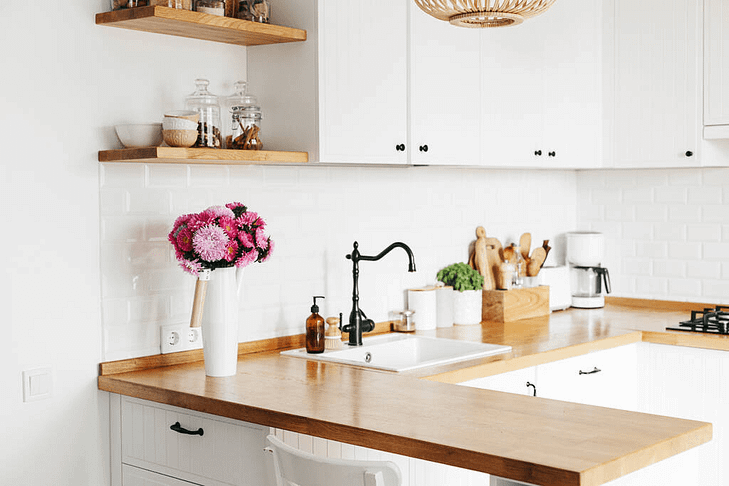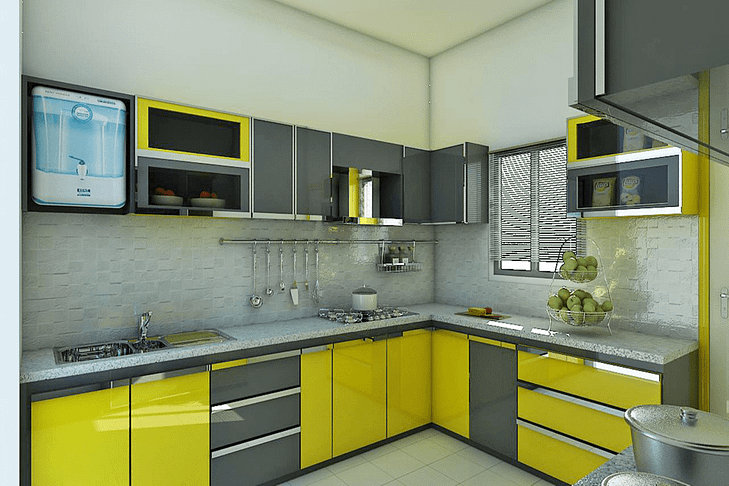Keeping your kitchen cabinets clean and well-maintained is essential for both the aesthetic appeal and functionality of your kitchen.
Over time, cabinets can accumulate dirt, grease, and grime, making them appear dull and unattractive.
In this comprehensive guide, we will provide you with expert tips and techniques to effectively clean and maintain your kitchen cabinets, ensuring they remain in pristine condition for years to come.
Cleaning tips for kitchen cabinets
Understanding the Material of Your Cabinets
Before diving into the cleaning process, it's important to understand the material your kitchen cabinets are made of.
Different materials require specific cleaning methods to avoid damage.
Here are some common cabinet materials:

1. Wood Cabinets
Wood is a popular choice for kitchen cabinets due to its durability and timeless appeal.
However, it is susceptible to water damage and requires special care during cleaning.
To clean wood cabinets:
- Start by removing any loose dirt or dust using a soft cloth or a feather duster.
- Mix a gentle cleaning solution using warm water and mild dish soap.
- Dip a clean cloth into the solution and wring out any excess liquid.
- Gently wipe down the cabinets, working in small sections.
- Rinse the cloth frequently and change the water as needed.
- Dry the cabinets thoroughly with a clean, dry cloth to prevent moisture damage.

2. Laminate Cabinets
Laminate cabinets are known for their affordability and easy maintenance.
They are resistant to stains and can be cleaned using basic household items.
To clean laminate cabinets:
- Start by removing any surface debris using a soft brush or microfiber cloth.
- Create a cleaning solution by mixing warm water and mild detergent.
- Dampen a sponge or cloth in the solution and wring out excess moisture.
- Wipe down the cabinets, focusing on any stubborn stains.
- Rinse the sponge or cloth frequently to avoid spreading dirt.
- Finish by wiping the cabinets with a clean, damp cloth to remove any soap residue.

3. Metal Cabinets
Metal cabinets, such as stainless steel or aluminum, are highly durable and resistant to stains.
However, they can develop fingerprints and smudges over time.
To clean metal cabinets:
- Start by removing any loose dirt or dust using a soft cloth or feather duster.
- Create a cleaning solution by mixing warm water with a few drops of mild dish soap.
- Dampen a microfiber cloth in the solution and wring out excess liquid.
- Gently wipe down the cabinets, following the grain of the metal.
- For stubborn stains or fingerprints, use a non-abrasive cleaner specifically designed for metal surfaces.
- Rinse the cloth frequently and change the water as needed.
- Dry the cabinets thoroughly with a clean, dry cloth to prevent water spots.
Deep Cleaning Techniques
Regular cleaning is essential, but occasional deep cleaning is necessary to remove stubborn stains, grease buildup, and odors from your kitchen cabinets.
Here are some effective deep cleaning techniques:

1. Removing Grease Buildup
Kitchen cabinets are prone to grease buildup, especially those located near the stove.
To remove stubborn grease:
- Mix equal parts vinegar and warm water in a spray bottle.
- Spray the solution onto the greasy areas of the cabinet.
- Let it sit for a few minutes to soften the grease.
- Scrub the surface gently using a soft-bristle brush or sponge.
- Rinse with warm water and dry thoroughly.

2. Removing Stubborn Stains
Stubborn stains can be unsightly and challenging to remove.
Here's how to tackle them effectively:
- Create a paste by mixing baking soda with water until it forms a thick consistency.
- Apply the paste directly to the stain and let it sit for 10-15 minutes.
- Gently scrub the stained area using a soft cloth or sponge.
- Rinse with warm water and dry thoroughly.

3. Eliminating Odors
If your kitchen cabinets have developed unpleasant odors, try these natural remedies:
- Place an open box of baking soda inside each cabinet to absorb odors.
- Alternatively, you can sprinkle baking soda directly onto a damp cloth and wipe down the interior of the cabinets.
- For stronger odors, mix equal parts vinegar and water in a spray bottle, then spray the interior of the cabinets. Let it sit for a few minutes before wiping with a clean cloth.

Tips for Daily Maintenance
In addition to regular cleaning, implementing daily maintenance habits can significantly extend the life of your kitchen cabinets.
Here are some tips for keeping them looking their best:
1. Wipe Down Surfaces
After each use of the kitchen, take a few moments to wipe down the cabinet doors, handles, and knobs with a damp cloth or mild cleaning solution.
This will help remove any surface dirt or spills before they have a chance to harden or leave stains.
2. Use Cabinet Liners
Consider lining your cabinet shelves and drawers with protective liners.
These liners not only add an extra layer of cleanliness but also help prevent scratches and other damage caused by items placed directly on the cabinet surfaces.
3. Avoid Excess Moisture
Excessive moisture can cause wood cabinets to warp or laminate surfaces to peel.
To prevent this:
- Avoid placing wet dishes or hot pots directly on cabinet surfaces; always use coasters or trivets.
- Wipe up any spills immediately to prevent them from seeping into the cabinet material.
- Ensure proper ventilation in your kitchen to limit humidity levels.

Polishing and Restoring Kitchen Cabinets
Over time, kitchen cabinets may lose their luster and develop minor scratches or signs of wear.
Here's how you can polish and restore them:
1. Polishing Wood Cabinets
Wood cabinets can be restored using furniture polish specifically designed for wood surfaces.
Follow these steps:
- Clean the cabinets using a gentle wood cleaner as mentioned earlier.
- Apply a small amount of wood polish onto a clean cloth.
- Gently rub the polish onto the cabinet surfaces in circular motions.
- Buff off any excess polish with a separate clean cloth.
2. Restoring Laminate Cabinets
Laminate cabinets can be rejuvenated using a mixture of equal parts vinegar and water.
Follow these steps:
- Clean the cabinets using a mild detergent solution as mentioned earlier.
- Dampen a cloth in the vinegar-water mixture and wring out excess moisture.
- Wipe down the laminate surfaces, focusing on areas with scratches or signs of wear.
- Rinse with warm water and dry thoroughly.
3. Restoring Metal Cabinets
Metal cabinets can be restored using metal polish specifically designed for stainless steel or aluminum surfaces.
Follow these steps:
- Clean the cabinets using a gentle metal cleaner as mentioned earlier.
- Apply a small amount of metal polish onto a clean cloth.
- Gently rub the polish onto the cabinet surfaces in circular motions.
- Buff off any excess polish with a separate clean cloth.
Additional cleaning tips you may find helpful:
Looking for recommendations for the cleaning supplies to get?
Continue reading on:
- 20 Best Cleaning Solution for Hardwood Floors
- 20 Best Cleaning Robots
- 20 Best Cleaning Gloves
- 30 Best Cleaning Laundry Detergents
- 30 Best Cleaning Solution for Laminate Floors
- 50 Best Cleaning Tools
- 50 Best Cleaning Supplies
- 59 Best Cleaning Products
- 20 Top Cleaning Gadgets for a Sparkling Home
- 21 Top Cleaning Tools for a Sparkling Home
- 10 Top Cleaning Products
Conclusion
By implementing these cleaning tips and maintenance strategies, you can ensure that your kitchen cabinets remain clean, organized, and visually appealing for years to come.
Regular cleaning, deep cleaning when necessary, daily maintenance habits, and occasional polishing will help preserve their beauty and functionality over time.
Remember to always follow manufacturer's guidelines for specific care instructions based on your cabinet material.
